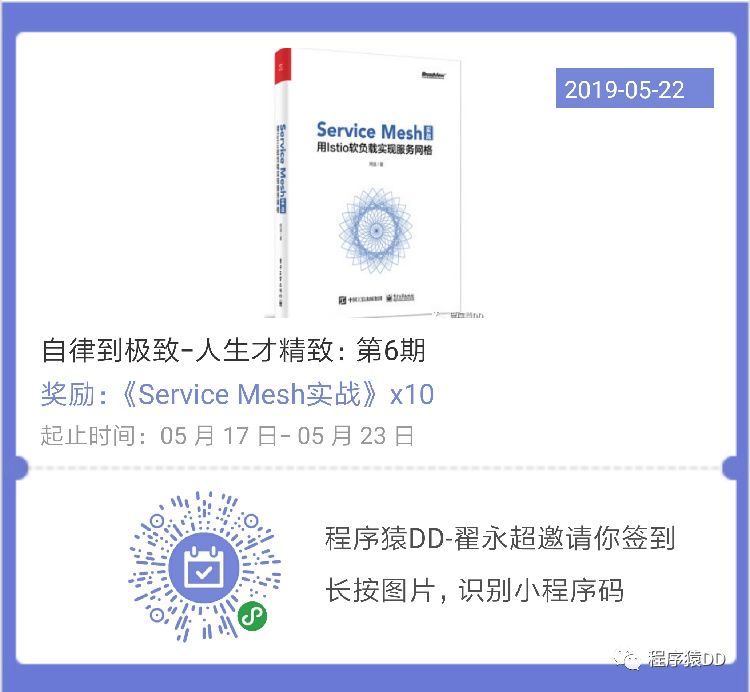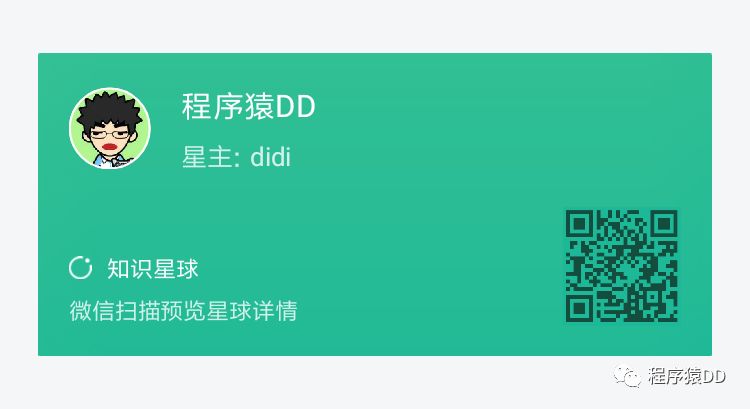点击蓝色“程序猿DD”关注我哟
加个“星标”,不忘签到哦

上一篇我们介绍了如何通过改造Sentinel Dashboard来实现修改规则之后自动同步到Apollo。下面通过这篇,详细介绍当使用Nacos作为配置中心之后,如何实现Sentinel Dashboard中修改规则同步到Nacos。关于下面改造的原理和分析可以见上一篇《Sentinel Dashboard中修改规则同步到Apollo》的头两节内容,本篇就不重复介绍了。
代码实现
下面直接来看看如何实现的具体改造步骤,这里参考了 SentinelDashboard源码中关于Nacos实现的测试用例。但是由于考虑到与Spring Cloud Alibaba的结合使用,略作修改。
第一步:修改 pom.xml中的sentinel-datasource-nacos的依赖,将 <scope>test</scope>注释掉,这样才能在主程序中使用。
<dependency><groupId>com.alibaba.csp</groupId><artifactId>sentinel-datasource-nacos</artifactId><!--<scope>test</scope>--></dependency>
第二步:找到 resources/app/scripts/directives/sidebar/sidebar.html中的这段代码:
<li ui-sref-active="active"><a ui-sref="dashboard.flowV1({app: entry.app})"><i class="glyphicon glyphicon-filter"></i> 流控规则</a></li>
修改为:
<li ui-sref-active="active"><a ui-sref="dashboard.flow({app: entry.app})"><i class="glyphicon glyphicon-filter"></i> 流控规则</a></li>
第三步:在 com.alibaba.csp.sentinel.dashboard.rule包下新建一个nacos包,用来编写针对Nacos的扩展实现。
第四步:创建Nacos的配置类,具体代码如下:
@Configurationpublic class NacosConfig {@Beanpublic Converter<List<FlowRuleEntity>, String> flowRuleEntityEncoder() {return JSON::toJSONString;}@Beanpublic Converter<String, List<FlowRuleEntity>> flowRuleEntityDecoder() {return s -> JSON.parseArray(s, FlowRuleEntity.class);}@Beanpublic ConfigService nacosConfigService() throws Exception {Properties properties = new Properties();properties.put(PropertyKeyConst.SERVER_ADDR, "localhost");return ConfigFactory.createConfigService(properties);}}
如果用到了namespace隔离环境,可以在 nacosConfigService方法中再加入配置,比如: properties.put(PropertyKeyConst.NAMESPACE,"130e71fa-97fe-467d-ad77-967456f2c16d");
第五步:实现Nacos的配置拉取。
@Component("flowRuleNacosProvider")public class FlowRuleNacosProvider implements DynamicRuleProvider<List<FlowRuleEntity>> {@Autowiredprivate ConfigService configService;@Autowiredprivate Converter<String, List<FlowRuleEntity>> converter;public static final String FLOW_DATA_ID_POSTFIX = "-sentinel";public static final String GROUP_ID = "DEFAULT_GROUP";@Overridepublic List<FlowRuleEntity> getRules(String appName) throws Exception {String rules = configService.getConfig(appName + FLOW_DATA_ID_POSTFIX, GROUP_ID, 3000);if (StringUtil.isEmpty(rules)) {return new ArrayList<>();}return converter.convert(rules);}}
getRules方法中的appName参数是Sentinel中的服务名称。configService.getConfig方法是从Nacos中获取配置信息的具体操作。其中,DataId和GroupId分别对应客户端使用时候的对应配置。比如这里的例子对应了之前我们在《Sentinel使用Nacos存储规则》一文中的配置,具体如下:
spring.cloud.sentinel.datasource.ds.nacos.groupId=DEFAULT_GROUPspring.cloud.sentinel.datasource.ds.nacos.dataId=${spring.application.name}-sentinel
注意:两边的DataId和GroupId必须对应上。
第六步:实现Nacos的配置推送。
@Component("flowRuleNacosPublisher")public class FlowRuleNacosPublisher implements DynamicRulePublisher<List<FlowRuleEntity>> {@Autowiredprivate ConfigService configService;@Autowiredprivate Converter<List<FlowRuleEntity>, String> converter;public static final String FLOW_DATA_ID_POSTFIX = "-sentinel";public static final String GROUP_ID = "DEFAULT_GROUP";@Overridepublic void publish(String app, List<FlowRuleEntity> rules) throws Exception {AssertUtil.notEmpty(app, "app name cannot be empty");if (rules == null) {return;}configService.publishConfig(app + FLOW_DATA_ID_POSTFIX, GROUP_ID, converter.convert(rules));}}
这里的大部分内容与上一步中的实现一致。主要就是Nacos中存储配置的DataId和GroupId不要弄错。
第七步:修改 com.alibaba.csp.sentinel.dashboard.controller.v2.FlowControllerV2中 DynamicRuleProvider和 DynamicRulePublisher注入的Bean,改为上面我们编写的针对Apollo的实现:
@Autowired@Qualifier("flowRuleNacosProvider")private DynamicRuleProvider<List<FlowRuleEntity>> ruleProvider;@Autowired@Qualifier("flowRuleNacosPublisher")private DynamicRulePublisher<List<FlowRuleEntity>> rulePublisher;
最后,读者可以使用本文改造后的sentinel-dashboard联合之前《Sentinel使用Nacos存储规则》一文的例子来验证本文内容。
代码示例
本文介绍内容的客户端代码,示例读者可以通过查看下面仓库中的 alibaba-sentinel-dashboard-nacos项目:
Github:https://github.com/dyc87112/SpringCloud-Learning/
Gitee:https://gitee.com/didispace/SpringCloud-Learning/
如果您对这些感兴趣,欢迎star、follow、收藏、转发给予支持!
系列回顾
推荐阅读:
号外:最近整理了之前编写的一系列内容做成了PDF,关注我并回复相应口令获取:
- 001 :领取《Spring Boot基础教程》
- 002 :领取《Spring Cloud基础教程》
活动介绍:自律到极致-人生才精致:第6期
活动奖励:《Service Mesh实战》* 10
扫描下面二维码签到参与

关注我,加个星标,不忘签到哦~
2019
与大家聊聊技术人的斜杠生活





















 429
429











 被折叠的 条评论
为什么被折叠?
被折叠的 条评论
为什么被折叠?








